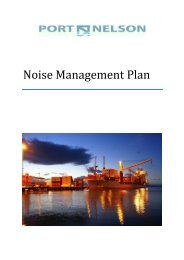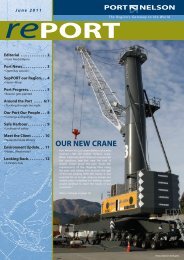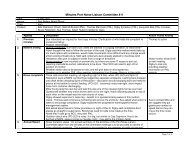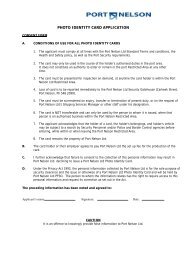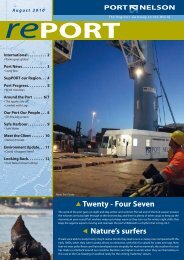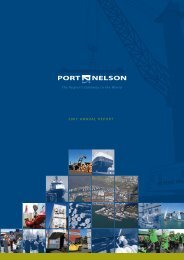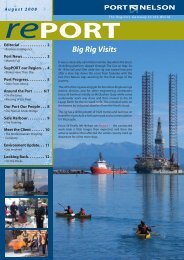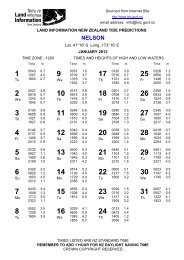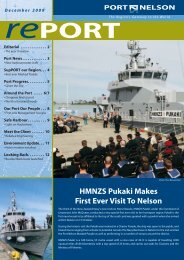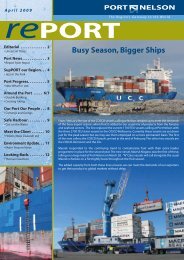Port Nelson Annual Report 2012 (pdf)
Port Nelson Annual Report 2012 (pdf)
Port Nelson Annual Report 2012 (pdf)
Create successful ePaper yourself
Turn your PDF publications into a flip-book with our unique Google optimized e-Paper software.
notes to the accounts<br />
notes<br />
note 15: intangible assets<br />
Accumulated<br />
Accumulated<br />
Ammortisation Current Current Ammortisation<br />
and Current Year Year Cost/ and<br />
Cost/ Impairment Carrying Year Current Impair- Ammort- Revalu- Impairment Carrying<br />
Revaluation Charges Amount Additions/ Year ment isation ation Charges Amt<br />
1/07/11 1/07/11 1/07/11 Transfers Disposals Charges Charges 30/6/12 30/6/12 30/6/12<br />
$000 $000 $000 $000 $000 $000 $000 $000 $000 $000<br />
<strong>2012</strong> asset class<br />
Software 3,525 (2,726) 799 283 - - (354) 3,808 (3,080) 728<br />
3,525 (2,726) 799 283 - - (354) 3,808 (3,080) 728<br />
2011 asset class<br />
Software 3,383 (2,381) 1,002 142 - - (345) 3,525 (2,726) 799<br />
3,383 (2,381) 1,002 142 - - (345) 3,525 (2726) 799<br />
All Intangible Assets are externally generated.<br />
note 16: financial instruments<br />
Financial Risk Management Objectives<br />
<strong>Port</strong> <strong>Nelson</strong> does not enter into or trade financial instruments, including derivative financial instruments for speculative purposes. Treasury<br />
functions are governed by a Treasury Policy approved by the Board of Directors. Approved instruments include:<br />
• Forward rate agreements<br />
• Options on a swap<br />
• Interest rate collars<br />
• Interest rate swaps<br />
• Interest rate options<br />
• Spot and forward foreign exchange<br />
Fixed rate hedging parameters are as follows:<br />
Term Minimum Fixed Rate Amount Maximum Fixed Rate Amount<br />
Less than 1 year 50% 100%<br />
1 year to 4 years 30% 70%<br />
5 years to 10 years 0% 50%<br />
Market Risk<br />
Currency Risk<br />
<strong>Port</strong> <strong>Nelson</strong> purchases plant and equipment from time to time from overseas which require it to enter into forward foreign exchange<br />
contracts to hedge the foreign currency risk exposure. This means that <strong>Port</strong> <strong>Nelson</strong> is able to fix the New Zealand dollar amount payable<br />
prior to delivery of the plant and equipment from overseas. As at balance date <strong>Port</strong> <strong>Nelson</strong> had NIL currency risk exposure.<br />
Cash flow interest rate risk<br />
Cash flow interest rate risk is the risk that the cash flows from a financial instrument will fluctuate due to changes in market interest rates.<br />
Borrowings issued at variable interest rates expose <strong>Port</strong> <strong>Nelson</strong> to cash flow interest rate risk.<br />
<strong>Port</strong> <strong>Nelson</strong>’s Treasury Policy is to maintain a portion of its borrowings using interest rate swap instruments within the parameters as set<br />
out in the Hedging Parameter table disclosed under the Financial Risk Management Objectives section. Under the interest rate swaps, <strong>Port</strong><br />
<strong>Nelson</strong> agrees with other parties to exchange, at specified intervals, the difference between fixed contract rates and floating-rate interest<br />
amounts calculated by reference to the agreed notional principle amounts.<br />
Credit Risk<br />
<strong>Port</strong> <strong>Nelson</strong> is exposed to credit risk from the possibility of counter-parties failing to perform their obligations.<br />
Credit risk exposure on financial assets other than cash at bank and at call has been recognised in the balance sheet net of any provision for<br />
doubtful debts. Principally any risk is in respect of cash and bank, and accounts receivable.<br />
The major components of debtor exposure are to shipping companies and forestry exporters. Terms of trade are either payment on the 20th<br />
of the month following or 7 working days. The majority of debtors are major international companies with extensive histories of payment.<br />
There are no major concentrations of credit risk with respect to accounts receivable and any single debtor.<br />
34



